Social Determinants of Health and Aboriginal Health in Australia
VerifiedAdded on 2022/08/24
|8
|1791
|33
Report
AI Summary
This report provides a comprehensive analysis of the social determinants of health impacting Aboriginal Australians. It begins by identifying Aboriginal Australians as a population group experiencing adverse health outcomes and then specifies two key social determinants: income inequality and lack of basic amenities. The report examines the current health status of Aboriginals, highlighting disparities in health outcomes compared to non-indigenous populations, including higher rates of chronic diseases, mental health issues, and reduced life expectancy. It explores how income inequality, limited access to essential services, and poor living conditions contribute to these health disparities. The report further investigates the interaction between these social factors, emphasizing how they intersect and exacerbate health challenges. For example, lack of income limits access to healthcare, nutritious food, and safe housing, and lack of basic amenities such as water sanitation, which is critical for maintaining health and well-being. The report concludes by emphasizing the need for government and health organizations to address these social determinants through educational initiatives, income management, and training programs to improve Aboriginal health outcomes and reduce health inequities. The report is based on the assignment brief that requires a rapid review of the literature on the health status of a specified population, and the impact of the social factors on the health outcomes of this population.
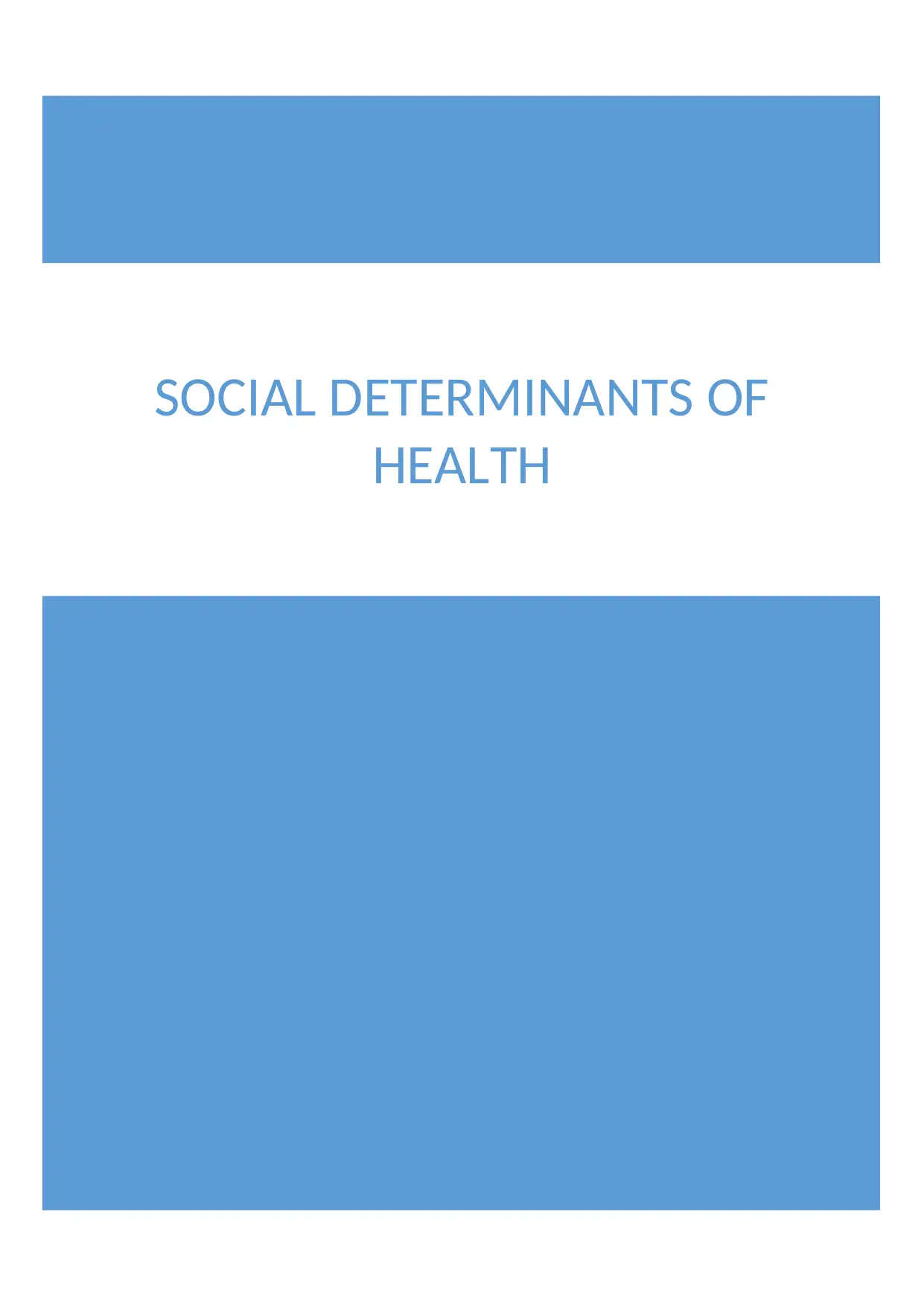
SOCIAL DETERMINANTS OF
HEALTH
HEALTH
Paraphrase This Document
Need a fresh take? Get an instant paraphrase of this document with our AI Paraphraser

Contents
Introduction...........................................................................................................................................3
Specification of population Group in Australia.....................................................................................3
Examination of two social determinants and their impact....................................................................3
Current health status of Aboriginals......................................................................................................5
Interaction between the social factors....................................................................................................5
Conclusion.............................................................................................................................................6
References.............................................................................................................................................7
Introduction...........................................................................................................................................3
Specification of population Group in Australia.....................................................................................3
Examination of two social determinants and their impact....................................................................3
Current health status of Aboriginals......................................................................................................5
Interaction between the social factors....................................................................................................5
Conclusion.............................................................................................................................................6
References.............................................................................................................................................7
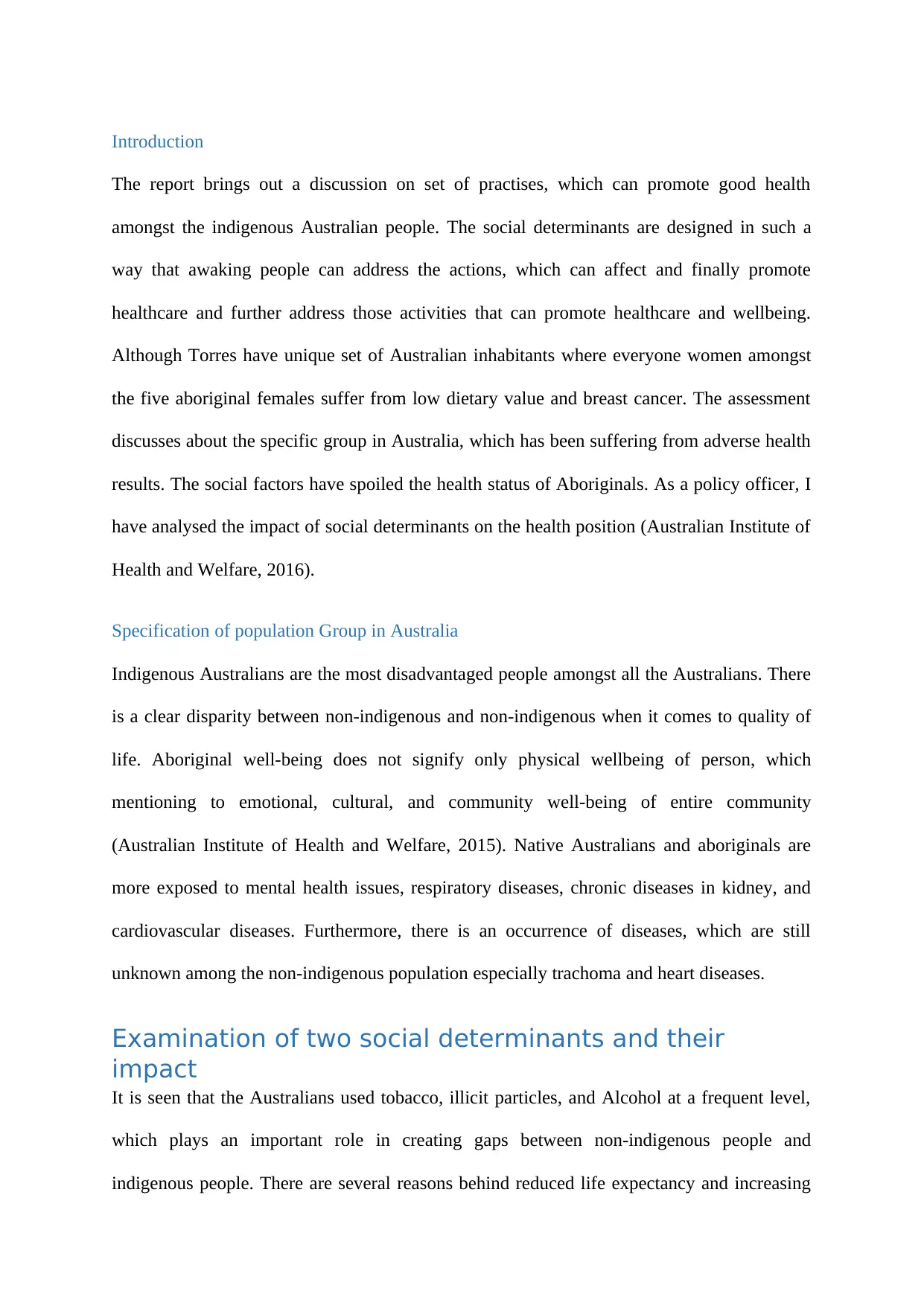
Introduction
The report brings out a discussion on set of practises, which can promote good health
amongst the indigenous Australian people. The social determinants are designed in such a
way that awaking people can address the actions, which can affect and finally promote
healthcare and further address those activities that can promote healthcare and wellbeing.
Although Torres have unique set of Australian inhabitants where everyone women amongst
the five aboriginal females suffer from low dietary value and breast cancer. The assessment
discusses about the specific group in Australia, which has been suffering from adverse health
results. The social factors have spoiled the health status of Aboriginals. As a policy officer, I
have analysed the impact of social determinants on the health position (Australian Institute of
Health and Welfare, 2016).
Specification of population Group in Australia
Indigenous Australians are the most disadvantaged people amongst all the Australians. There
is a clear disparity between non-indigenous and non-indigenous when it comes to quality of
life. Aboriginal well-being does not signify only physical wellbeing of person, which
mentioning to emotional, cultural, and community well-being of entire community
(Australian Institute of Health and Welfare, 2015). Native Australians and aboriginals are
more exposed to mental health issues, respiratory diseases, chronic diseases in kidney, and
cardiovascular diseases. Furthermore, there is an occurrence of diseases, which are still
unknown among the non-indigenous population especially trachoma and heart diseases.
Examination of two social determinants and their
impact
It is seen that the Australians used tobacco, illicit particles, and Alcohol at a frequent level,
which plays an important role in creating gaps between non-indigenous people and
indigenous people. There are several reasons behind reduced life expectancy and increasing
The report brings out a discussion on set of practises, which can promote good health
amongst the indigenous Australian people. The social determinants are designed in such a
way that awaking people can address the actions, which can affect and finally promote
healthcare and further address those activities that can promote healthcare and wellbeing.
Although Torres have unique set of Australian inhabitants where everyone women amongst
the five aboriginal females suffer from low dietary value and breast cancer. The assessment
discusses about the specific group in Australia, which has been suffering from adverse health
results. The social factors have spoiled the health status of Aboriginals. As a policy officer, I
have analysed the impact of social determinants on the health position (Australian Institute of
Health and Welfare, 2016).
Specification of population Group in Australia
Indigenous Australians are the most disadvantaged people amongst all the Australians. There
is a clear disparity between non-indigenous and non-indigenous when it comes to quality of
life. Aboriginal well-being does not signify only physical wellbeing of person, which
mentioning to emotional, cultural, and community well-being of entire community
(Australian Institute of Health and Welfare, 2015). Native Australians and aboriginals are
more exposed to mental health issues, respiratory diseases, chronic diseases in kidney, and
cardiovascular diseases. Furthermore, there is an occurrence of diseases, which are still
unknown among the non-indigenous population especially trachoma and heart diseases.
Examination of two social determinants and their
impact
It is seen that the Australians used tobacco, illicit particles, and Alcohol at a frequent level,
which plays an important role in creating gaps between non-indigenous people and
indigenous people. There are several reasons behind reduced life expectancy and increasing
⊘ This is a preview!⊘
Do you want full access?
Subscribe today to unlock all pages.

Trusted by 1+ million students worldwide
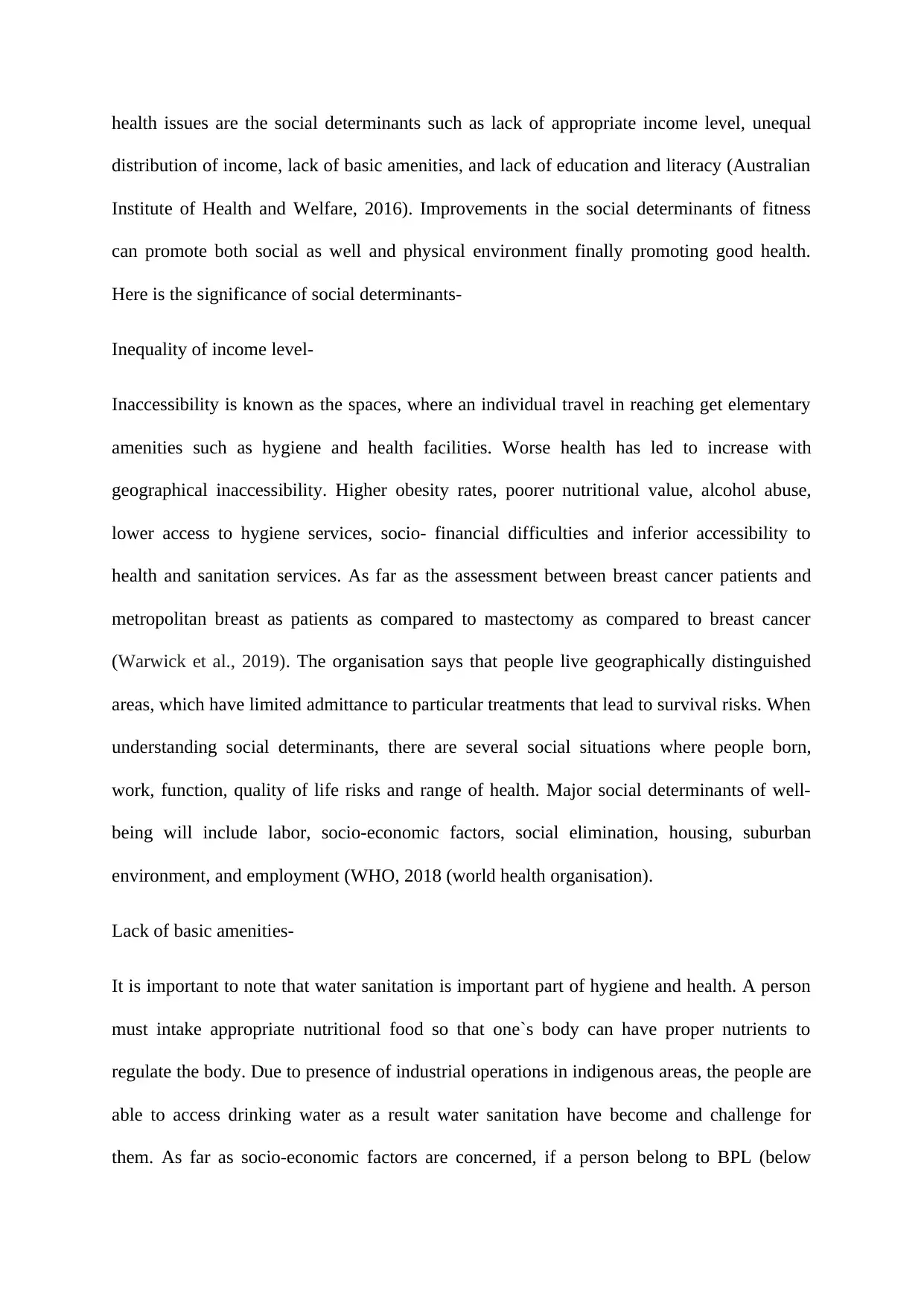
health issues are the social determinants such as lack of appropriate income level, unequal
distribution of income, lack of basic amenities, and lack of education and literacy (Australian
Institute of Health and Welfare, 2016). Improvements in the social determinants of fitness
can promote both social as well and physical environment finally promoting good health.
Here is the significance of social determinants-
Inequality of income level-
Inaccessibility is known as the spaces, where an individual travel in reaching get elementary
amenities such as hygiene and health facilities. Worse health has led to increase with
geographical inaccessibility. Higher obesity rates, poorer nutritional value, alcohol abuse,
lower access to hygiene services, socio- financial difficulties and inferior accessibility to
health and sanitation services. As far as the assessment between breast cancer patients and
metropolitan breast as patients as compared to mastectomy as compared to breast cancer
(Warwick et al., 2019). The organisation says that people live geographically distinguished
areas, which have limited admittance to particular treatments that lead to survival risks. When
understanding social determinants, there are several social situations where people born,
work, function, quality of life risks and range of health. Major social determinants of well-
being will include labor, socio-economic factors, social elimination, housing, suburban
environment, and employment (WHO, 2018 (world health organisation).
Lack of basic amenities-
It is important to note that water sanitation is important part of hygiene and health. A person
must intake appropriate nutritional food so that one`s body can have proper nutrients to
regulate the body. Due to presence of industrial operations in indigenous areas, the people are
able to access drinking water as a result water sanitation have become and challenge for
them. As far as socio-economic factors are concerned, if a person belong to BPL (below
distribution of income, lack of basic amenities, and lack of education and literacy (Australian
Institute of Health and Welfare, 2016). Improvements in the social determinants of fitness
can promote both social as well and physical environment finally promoting good health.
Here is the significance of social determinants-
Inequality of income level-
Inaccessibility is known as the spaces, where an individual travel in reaching get elementary
amenities such as hygiene and health facilities. Worse health has led to increase with
geographical inaccessibility. Higher obesity rates, poorer nutritional value, alcohol abuse,
lower access to hygiene services, socio- financial difficulties and inferior accessibility to
health and sanitation services. As far as the assessment between breast cancer patients and
metropolitan breast as patients as compared to mastectomy as compared to breast cancer
(Warwick et al., 2019). The organisation says that people live geographically distinguished
areas, which have limited admittance to particular treatments that lead to survival risks. When
understanding social determinants, there are several social situations where people born,
work, function, quality of life risks and range of health. Major social determinants of well-
being will include labor, socio-economic factors, social elimination, housing, suburban
environment, and employment (WHO, 2018 (world health organisation).
Lack of basic amenities-
It is important to note that water sanitation is important part of hygiene and health. A person
must intake appropriate nutritional food so that one`s body can have proper nutrients to
regulate the body. Due to presence of industrial operations in indigenous areas, the people are
able to access drinking water as a result water sanitation have become and challenge for
them. As far as socio-economic factors are concerned, if a person belong to BPL (below
Paraphrase This Document
Need a fresh take? Get an instant paraphrase of this document with our AI Paraphraser
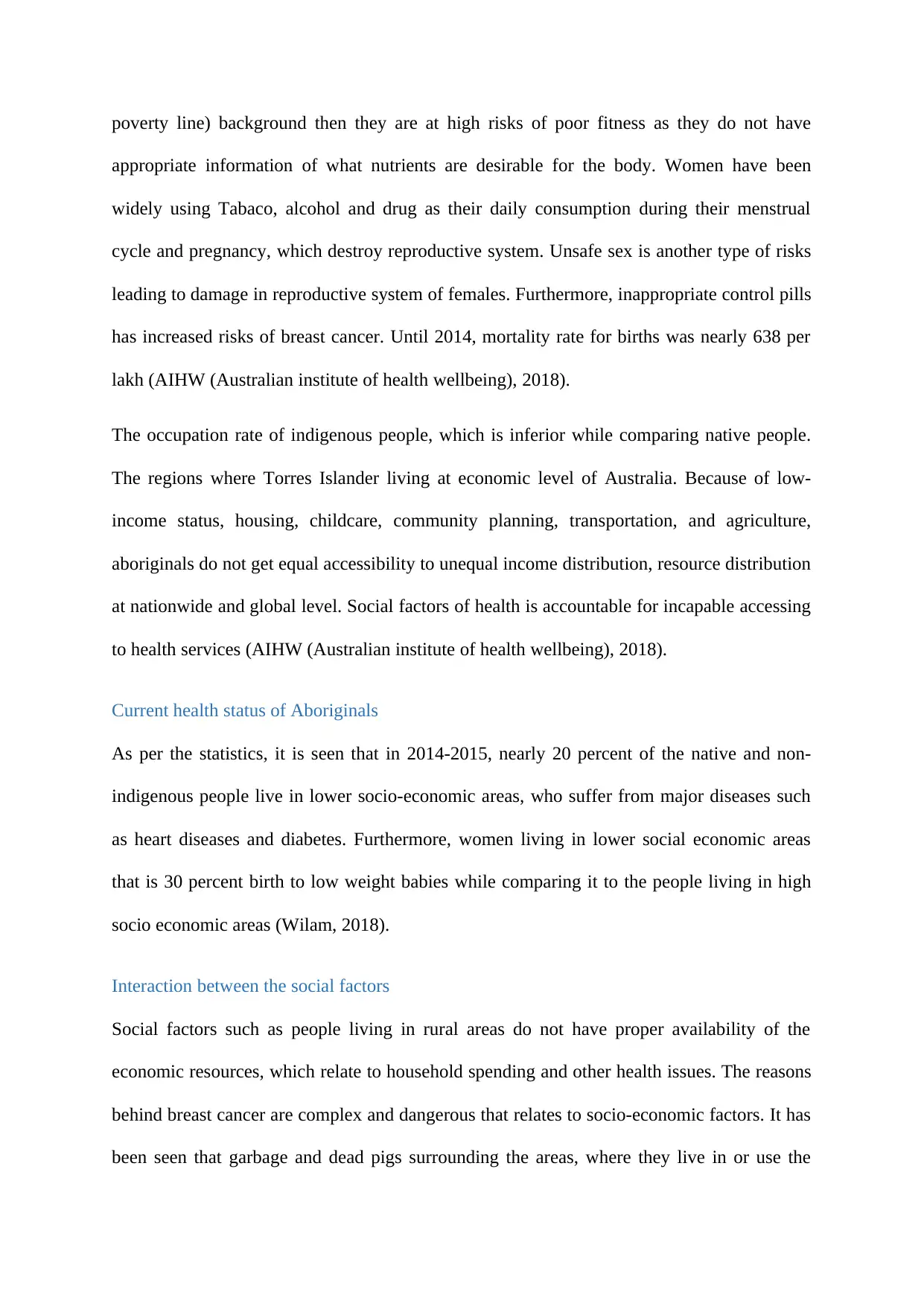
poverty line) background then they are at high risks of poor fitness as they do not have
appropriate information of what nutrients are desirable for the body. Women have been
widely using Tabaco, alcohol and drug as their daily consumption during their menstrual
cycle and pregnancy, which destroy reproductive system. Unsafe sex is another type of risks
leading to damage in reproductive system of females. Furthermore, inappropriate control pills
has increased risks of breast cancer. Until 2014, mortality rate for births was nearly 638 per
lakh (AIHW (Australian institute of health wellbeing), 2018).
The occupation rate of indigenous people, which is inferior while comparing native people.
The regions where Torres Islander living at economic level of Australia. Because of low-
income status, housing, childcare, community planning, transportation, and agriculture,
aboriginals do not get equal accessibility to unequal income distribution, resource distribution
at nationwide and global level. Social factors of health is accountable for incapable accessing
to health services (AIHW (Australian institute of health wellbeing), 2018).
Current health status of Aboriginals
As per the statistics, it is seen that in 2014-2015, nearly 20 percent of the native and non-
indigenous people live in lower socio-economic areas, who suffer from major diseases such
as heart diseases and diabetes. Furthermore, women living in lower social economic areas
that is 30 percent birth to low weight babies while comparing it to the people living in high
socio economic areas (Wilam, 2018).
Interaction between the social factors
Social factors such as people living in rural areas do not have proper availability of the
economic resources, which relate to household spending and other health issues. The reasons
behind breast cancer are complex and dangerous that relates to socio-economic factors. It has
been seen that garbage and dead pigs surrounding the areas, where they live in or use the
appropriate information of what nutrients are desirable for the body. Women have been
widely using Tabaco, alcohol and drug as their daily consumption during their menstrual
cycle and pregnancy, which destroy reproductive system. Unsafe sex is another type of risks
leading to damage in reproductive system of females. Furthermore, inappropriate control pills
has increased risks of breast cancer. Until 2014, mortality rate for births was nearly 638 per
lakh (AIHW (Australian institute of health wellbeing), 2018).
The occupation rate of indigenous people, which is inferior while comparing native people.
The regions where Torres Islander living at economic level of Australia. Because of low-
income status, housing, childcare, community planning, transportation, and agriculture,
aboriginals do not get equal accessibility to unequal income distribution, resource distribution
at nationwide and global level. Social factors of health is accountable for incapable accessing
to health services (AIHW (Australian institute of health wellbeing), 2018).
Current health status of Aboriginals
As per the statistics, it is seen that in 2014-2015, nearly 20 percent of the native and non-
indigenous people live in lower socio-economic areas, who suffer from major diseases such
as heart diseases and diabetes. Furthermore, women living in lower social economic areas
that is 30 percent birth to low weight babies while comparing it to the people living in high
socio economic areas (Wilam, 2018).
Interaction between the social factors
Social factors such as people living in rural areas do not have proper availability of the
economic resources, which relate to household spending and other health issues. The reasons
behind breast cancer are complex and dangerous that relates to socio-economic factors. It has
been seen that garbage and dead pigs surrounding the areas, where they live in or use the
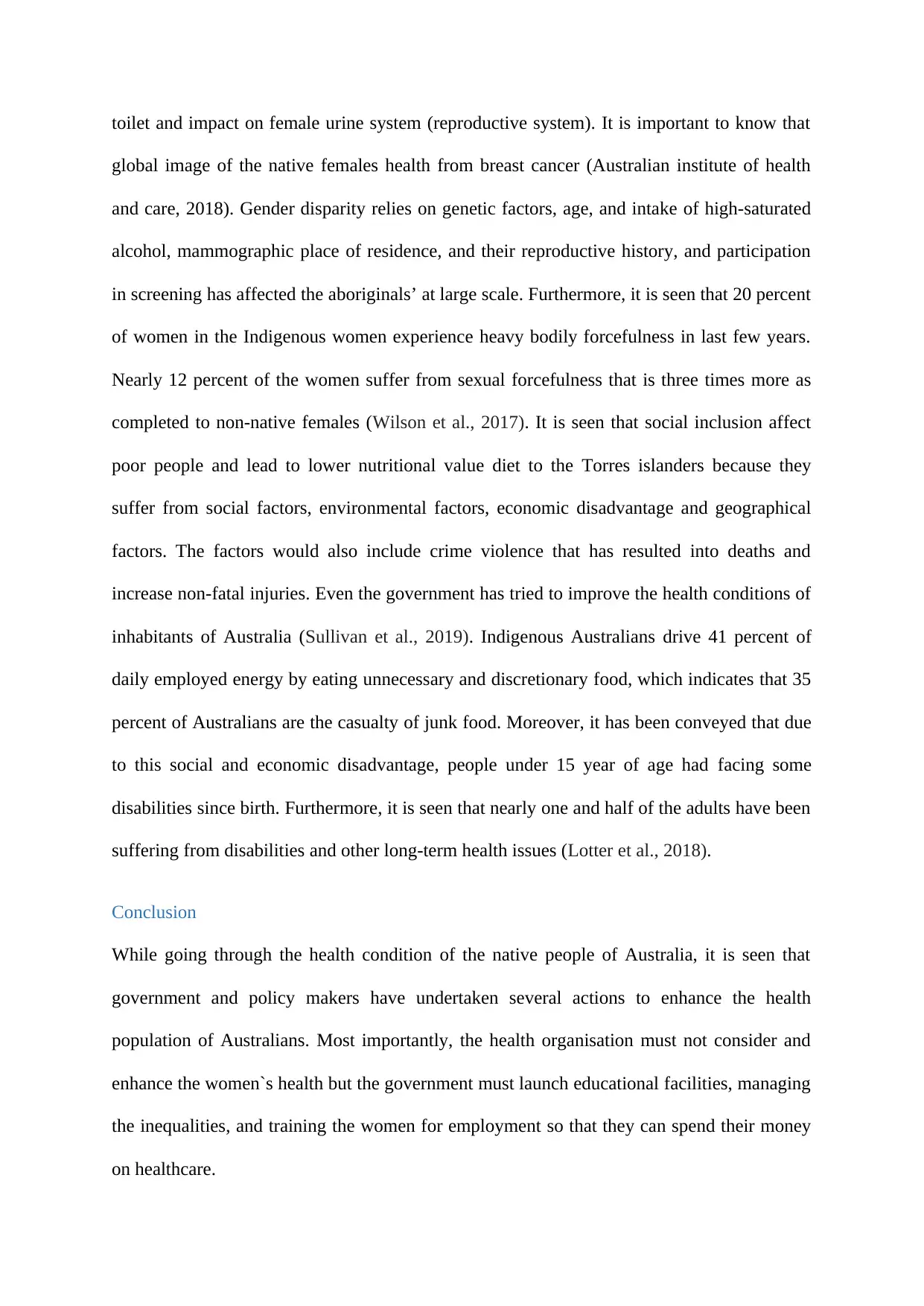
toilet and impact on female urine system (reproductive system). It is important to know that
global image of the native females health from breast cancer (Australian institute of health
and care, 2018). Gender disparity relies on genetic factors, age, and intake of high-saturated
alcohol, mammographic place of residence, and their reproductive history, and participation
in screening has affected the aboriginals’ at large scale. Furthermore, it is seen that 20 percent
of women in the Indigenous women experience heavy bodily forcefulness in last few years.
Nearly 12 percent of the women suffer from sexual forcefulness that is three times more as
completed to non-native females (Wilson et al., 2017). It is seen that social inclusion affect
poor people and lead to lower nutritional value diet to the Torres islanders because they
suffer from social factors, environmental factors, economic disadvantage and geographical
factors. The factors would also include crime violence that has resulted into deaths and
increase non-fatal injuries. Even the government has tried to improve the health conditions of
inhabitants of Australia (Sullivan et al., 2019). Indigenous Australians drive 41 percent of
daily employed energy by eating unnecessary and discretionary food, which indicates that 35
percent of Australians are the casualty of junk food. Moreover, it has been conveyed that due
to this social and economic disadvantage, people under 15 year of age had facing some
disabilities since birth. Furthermore, it is seen that nearly one and half of the adults have been
suffering from disabilities and other long-term health issues (Lotter et al., 2018).
Conclusion
While going through the health condition of the native people of Australia, it is seen that
government and policy makers have undertaken several actions to enhance the health
population of Australians. Most importantly, the health organisation must not consider and
enhance the women`s health but the government must launch educational facilities, managing
the inequalities, and training the women for employment so that they can spend their money
on healthcare.
global image of the native females health from breast cancer (Australian institute of health
and care, 2018). Gender disparity relies on genetic factors, age, and intake of high-saturated
alcohol, mammographic place of residence, and their reproductive history, and participation
in screening has affected the aboriginals’ at large scale. Furthermore, it is seen that 20 percent
of women in the Indigenous women experience heavy bodily forcefulness in last few years.
Nearly 12 percent of the women suffer from sexual forcefulness that is three times more as
completed to non-native females (Wilson et al., 2017). It is seen that social inclusion affect
poor people and lead to lower nutritional value diet to the Torres islanders because they
suffer from social factors, environmental factors, economic disadvantage and geographical
factors. The factors would also include crime violence that has resulted into deaths and
increase non-fatal injuries. Even the government has tried to improve the health conditions of
inhabitants of Australia (Sullivan et al., 2019). Indigenous Australians drive 41 percent of
daily employed energy by eating unnecessary and discretionary food, which indicates that 35
percent of Australians are the casualty of junk food. Moreover, it has been conveyed that due
to this social and economic disadvantage, people under 15 year of age had facing some
disabilities since birth. Furthermore, it is seen that nearly one and half of the adults have been
suffering from disabilities and other long-term health issues (Lotter et al., 2018).
Conclusion
While going through the health condition of the native people of Australia, it is seen that
government and policy makers have undertaken several actions to enhance the health
population of Australians. Most importantly, the health organisation must not consider and
enhance the women`s health but the government must launch educational facilities, managing
the inequalities, and training the women for employment so that they can spend their money
on healthcare.
⊘ This is a preview!⊘
Do you want full access?
Subscribe today to unlock all pages.

Trusted by 1+ million students worldwide
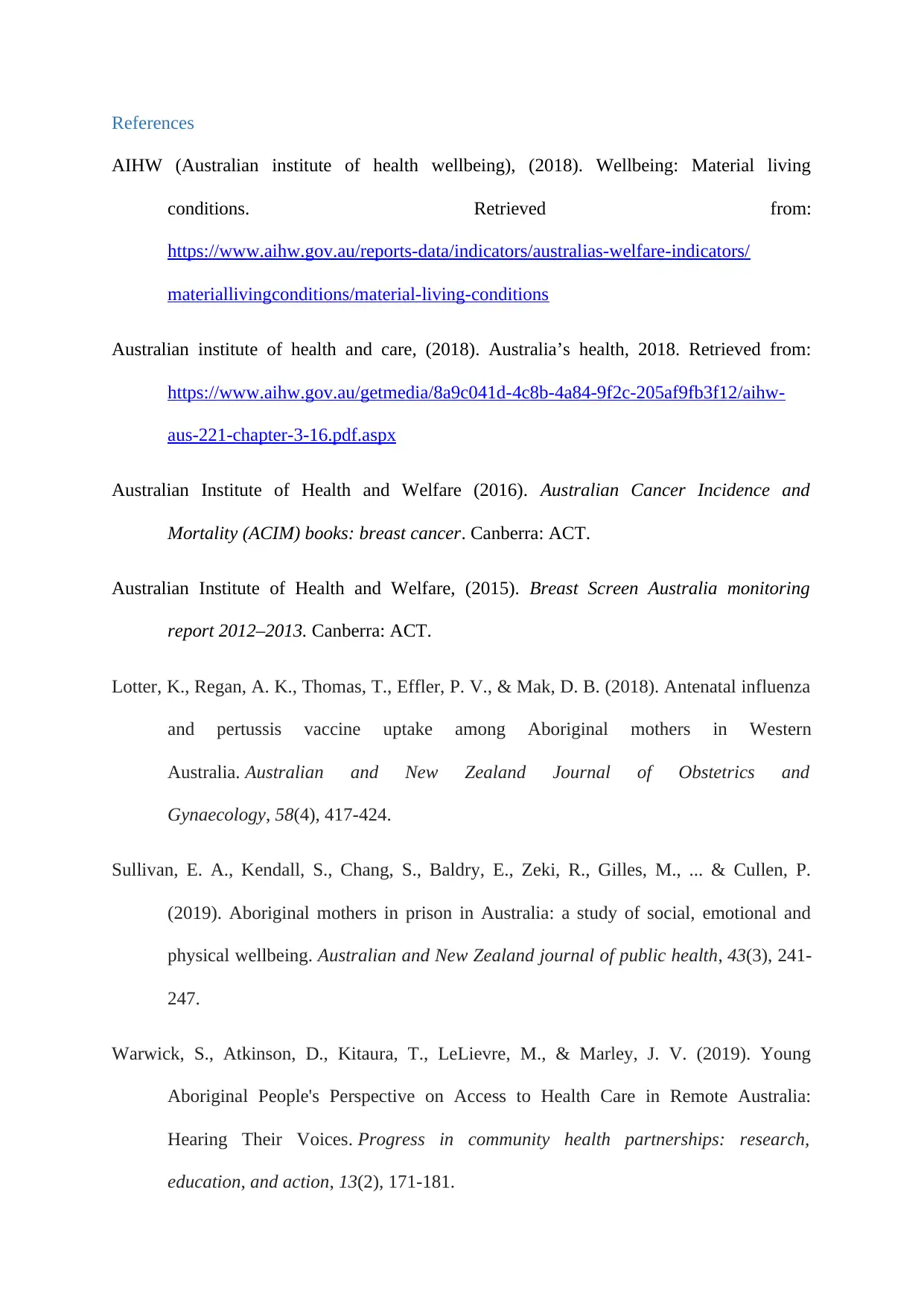
References
AIHW (Australian institute of health wellbeing), (2018). Wellbeing: Material living
conditions. Retrieved from:
https://www.aihw.gov.au/reports-data/indicators/australias-welfare-indicators/
materiallivingconditions/material-living-conditions
Australian institute of health and care, (2018). Australia’s health, 2018. Retrieved from:
https://www.aihw.gov.au/getmedia/8a9c041d-4c8b-4a84-9f2c-205af9fb3f12/aihw-
aus-221-chapter-3-16.pdf.aspx
Australian Institute of Health and Welfare (2016). Australian Cancer Incidence and
Mortality (ACIM) books: breast cancer. Canberra: ACT.
Australian Institute of Health and Welfare, (2015). Breast Screen Australia monitoring
report 2012–2013. Canberra: ACT.
Lotter, K., Regan, A. K., Thomas, T., Effler, P. V., & Mak, D. B. (2018). Antenatal influenza
and pertussis vaccine uptake among Aboriginal mothers in Western
Australia. Australian and New Zealand Journal of Obstetrics and
Gynaecology, 58(4), 417-424.
Sullivan, E. A., Kendall, S., Chang, S., Baldry, E., Zeki, R., Gilles, M., ... & Cullen, P.
(2019). Aboriginal mothers in prison in Australia: a study of social, emotional and
physical wellbeing. Australian and New Zealand journal of public health, 43(3), 241-
247.
Warwick, S., Atkinson, D., Kitaura, T., LeLievre, M., & Marley, J. V. (2019). Young
Aboriginal People's Perspective on Access to Health Care in Remote Australia:
Hearing Their Voices. Progress in community health partnerships: research,
education, and action, 13(2), 171-181.
AIHW (Australian institute of health wellbeing), (2018). Wellbeing: Material living
conditions. Retrieved from:
https://www.aihw.gov.au/reports-data/indicators/australias-welfare-indicators/
materiallivingconditions/material-living-conditions
Australian institute of health and care, (2018). Australia’s health, 2018. Retrieved from:
https://www.aihw.gov.au/getmedia/8a9c041d-4c8b-4a84-9f2c-205af9fb3f12/aihw-
aus-221-chapter-3-16.pdf.aspx
Australian Institute of Health and Welfare (2016). Australian Cancer Incidence and
Mortality (ACIM) books: breast cancer. Canberra: ACT.
Australian Institute of Health and Welfare, (2015). Breast Screen Australia monitoring
report 2012–2013. Canberra: ACT.
Lotter, K., Regan, A. K., Thomas, T., Effler, P. V., & Mak, D. B. (2018). Antenatal influenza
and pertussis vaccine uptake among Aboriginal mothers in Western
Australia. Australian and New Zealand Journal of Obstetrics and
Gynaecology, 58(4), 417-424.
Sullivan, E. A., Kendall, S., Chang, S., Baldry, E., Zeki, R., Gilles, M., ... & Cullen, P.
(2019). Aboriginal mothers in prison in Australia: a study of social, emotional and
physical wellbeing. Australian and New Zealand journal of public health, 43(3), 241-
247.
Warwick, S., Atkinson, D., Kitaura, T., LeLievre, M., & Marley, J. V. (2019). Young
Aboriginal People's Perspective on Access to Health Care in Remote Australia:
Hearing Their Voices. Progress in community health partnerships: research,
education, and action, 13(2), 171-181.
Paraphrase This Document
Need a fresh take? Get an instant paraphrase of this document with our AI Paraphraser

WHO, (2018) (world health organisation). Environmental health in emergencies. Retrieved
from: https://www.who.int/environmental_health_emergencies/vulnerable_groups/en/
Wilam, B. B., (2018). Aboriginal & Torres Strait Islander women. Retrieved from:
https://www.thewomens.org.au/patients-visitors/clinics-and-services/support-
services/aboriginal-torres-strait-islander-women
Wilson, M., Jones, J., Butler, T., Simpson, P., Gilles, M., Baldry, E., ... & Sullivan, E. (2017).
Violence in the lives of incarcerated Aboriginal mothers in Western Australia. Sage
open, 7(1), 2158244016686814.
from: https://www.who.int/environmental_health_emergencies/vulnerable_groups/en/
Wilam, B. B., (2018). Aboriginal & Torres Strait Islander women. Retrieved from:
https://www.thewomens.org.au/patients-visitors/clinics-and-services/support-
services/aboriginal-torres-strait-islander-women
Wilson, M., Jones, J., Butler, T., Simpson, P., Gilles, M., Baldry, E., ... & Sullivan, E. (2017).
Violence in the lives of incarcerated Aboriginal mothers in Western Australia. Sage
open, 7(1), 2158244016686814.
1 out of 8
Related Documents
Your All-in-One AI-Powered Toolkit for Academic Success.
+13062052269
info@desklib.com
Available 24*7 on WhatsApp / Email
![[object Object]](/_next/static/media/star-bottom.7253800d.svg)
Unlock your academic potential
Copyright © 2020–2025 A2Z Services. All Rights Reserved. Developed and managed by ZUCOL.





